Abstract
Based on previous experiments in nude mice, showing that fluoresceinated monoclonal antibodies against carcinoembryonic antigen localized specifically in human carcinoma xenografts and could be detected by laser-induced fluorescence, we performed a feasibility study to determine whether this immunophotodiagnosis method could be applied in the clinic. Six patients, with known primary colorectal carcinoma, received an i.v. injection of 4.5 or 9 mg of mouse-human chimeric anti-carcinoembryonic antigen monoclonal antibody coupled with 0.10-0.28 mg of fluorescein (molar ratio 1/10 to 1/14). The monoclonal antibody was also labeled with 0.2-0.4 mCi of 125I (1 Ci = 37 GBq). Photodetection of the tumor was done ex vivo on surgically resected tissues for the six patients and in vivo by fluorescence rectosigmoidoscopy for the sixth patient. Upon laser irradiation, clearly detectable heterogeneous green fluorescence from the dye-antibody conjugate was visually observed on all six tumors; almost no such fluorescence was detectable on normal mucosa. The yellowish tissue autofluorescence, which was emitted from both tumor and normal mucosa, could be subtracted by real-time image processing. Radioactivity measurements confirmed the specificity of tumor localization by the conjugate; tissue concentrations of up to 0.059% injected dose per g of tumor and 10 times less (0.006%) per g of normal mucosa were found. The overall results demonstrate the feasibility of tumor immunophotodiagnosis at the clinical level.
Full text
PDF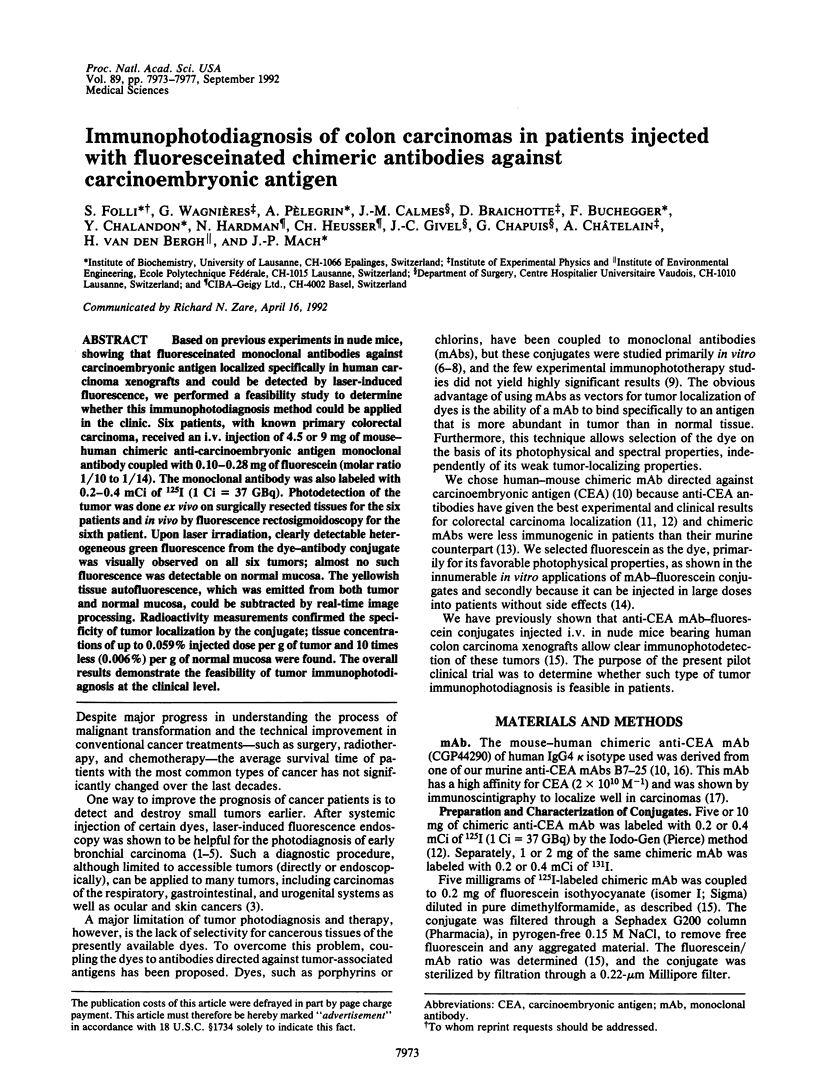
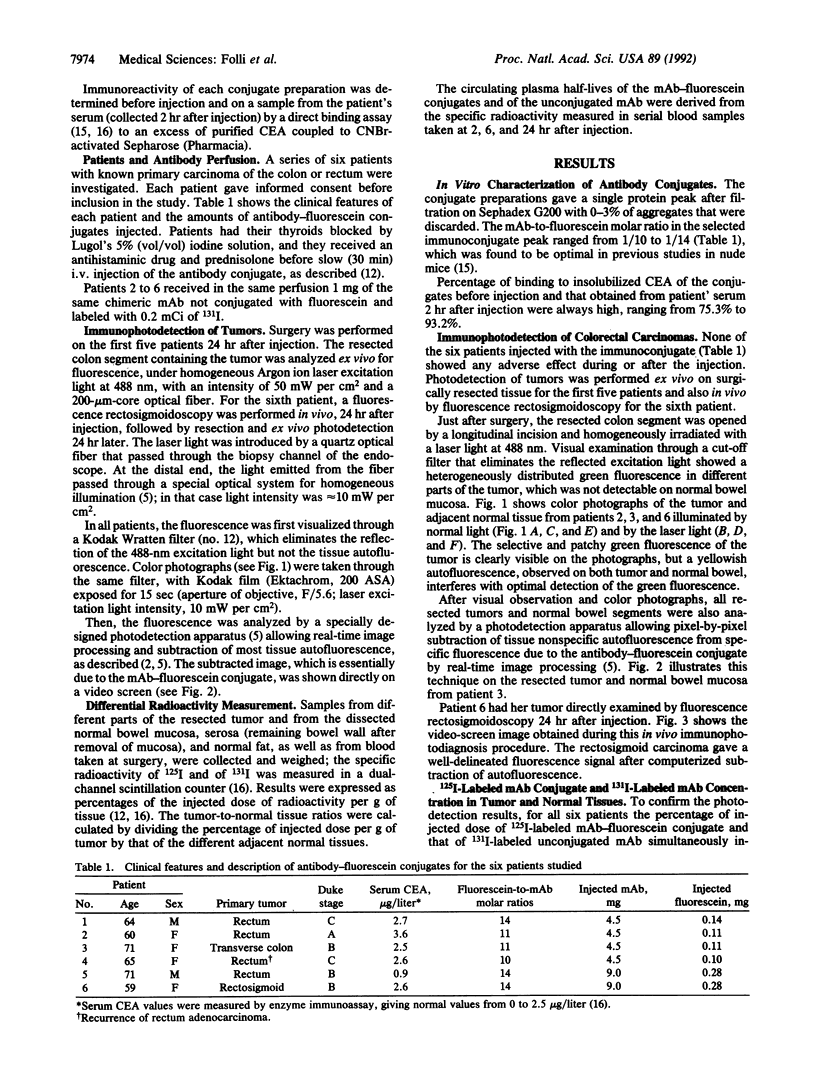
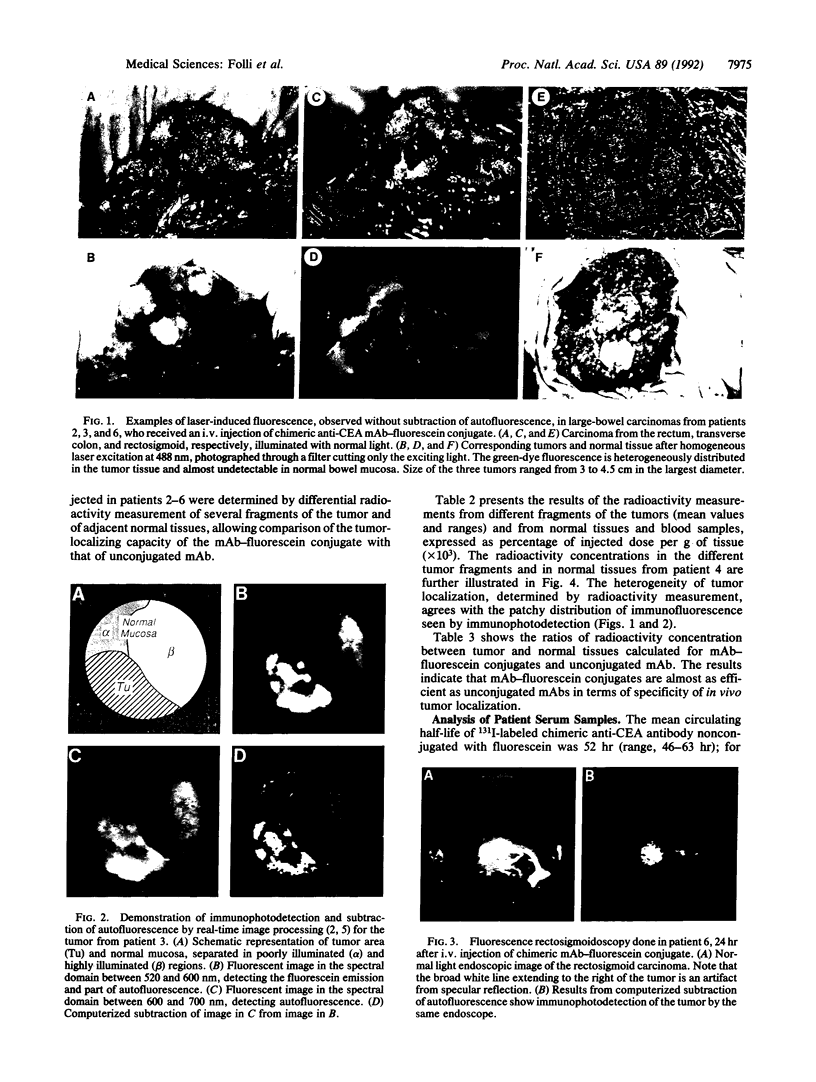
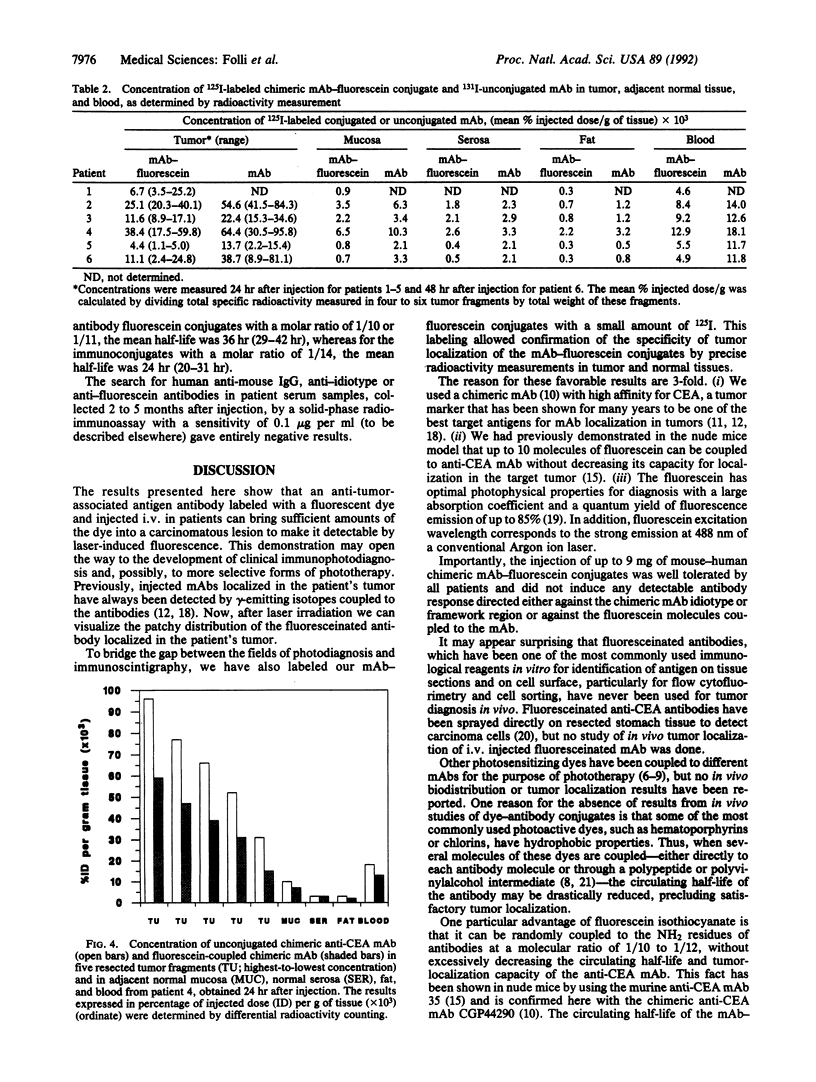
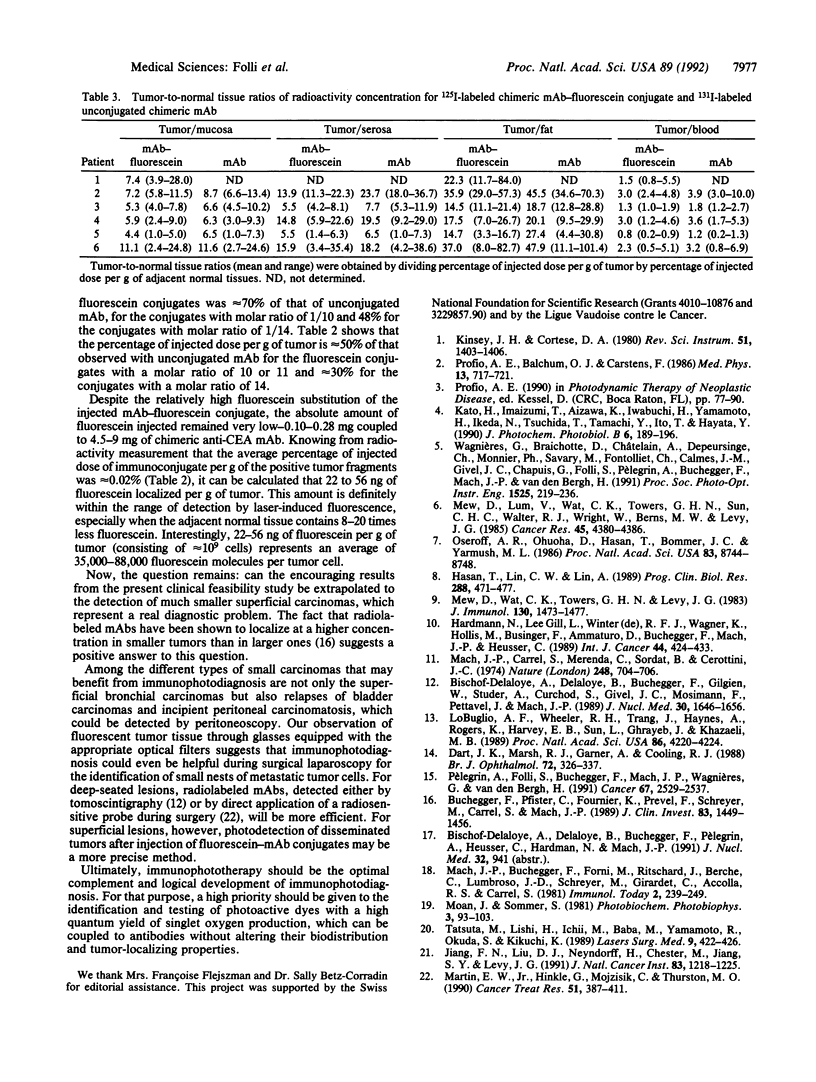
Images in this article
Selected References
These references are in PubMed. This may not be the complete list of references from this article.
- Bischof-Delaloye A., Delaloye B., Buchegger F., Gilgien W., Studer A., Curchod S., Givel J. C., Mosimann F., Pettavel J., Mach J. P. Clinical value of immunoscintigraphy in colorectal carcinoma patients: a prospective study. J Nucl Med. 1989 Oct;30(10):1646–1656. [PubMed] [Google Scholar]
- Buchegger F., Pfister C., Fournier K., Prevel F., Schreyer M., Carrel S., Mach J. P. Ablation of human colon carcinoma in nude mice by 131I-labeled monoclonal anti-carcinoembryonic antigen antibody F(ab')2 fragments. J Clin Invest. 1989 May;83(5):1449–1456. doi: 10.1172/JCI114037. [DOI] [PMC free article] [PubMed] [Google Scholar]
- Dart J. K., Marsh R. J., Garner A., Cooling R. J. Fluorescein angiography of anterior uveal melanocytic tumours. Br J Ophthalmol. 1988 May;72(5):326–337. doi: 10.1136/bjo.72.5.326. [DOI] [PMC free article] [PubMed] [Google Scholar]
- Hardman N., Gill L. L., De Winter R. F., Wagner K., Hollis M., Businger F., Ammaturo D., Buchegger F., Mach J. P., Heusser C. Generation of a recombinant mouse-human chimaeric monoclonal antibody directed against human carcinoembryonic antigen. Int J Cancer. 1989 Sep 15;44(3):424–433. doi: 10.1002/ijc.2910440308. [DOI] [PubMed] [Google Scholar]
- Hasan T., Lin C. W., Lin A. Laser-induced selective cytotoxicity using monoclonal antibody-chromophore conjugates. Prog Clin Biol Res. 1989;288:471–477. [PubMed] [Google Scholar]
- Jiang F. N., Liu D. J., Neyndorff H., Chester M., Jiang S. Y., Levy J. G. Photodynamic killing of human squamous cell carcinoma cells using a monoclonal antibody-photosensitizer conjugate. J Natl Cancer Inst. 1991 Sep 4;83(17):1218–1225. doi: 10.1093/jnci/83.17.1218. [DOI] [PubMed] [Google Scholar]
- Kato H., Imaizumi T., Aizawa K., Iwabuchi H., Yamamoto H., Ikeda N., Tsuchida T., Tamachi Y., Ito T., Hayata Y. Photodynamic diagnosis in respiratory tract malignancy using an excimer dye laser system. J Photochem Photobiol B. 1990 Jun;6(1-2):189–196. doi: 10.1016/1011-1344(90)85089-f. [DOI] [PubMed] [Google Scholar]
- Kinsey J. H., Cortese D. A. Endoscopic system for simultaneous visual examination and electronic detection of fluorescence. Rev Sci Instrum. 1980 Oct;51(10):1403–1406. doi: 10.1063/1.1136099. [DOI] [PubMed] [Google Scholar]
- LoBuglio A. F., Wheeler R. H., Trang J., Haynes A., Rogers K., Harvey E. B., Sun L., Ghrayeb J., Khazaeli M. B. Mouse/human chimeric monoclonal antibody in man: kinetics and immune response. Proc Natl Acad Sci U S A. 1989 Jun;86(11):4220–4224. doi: 10.1073/pnas.86.11.4220. [DOI] [PMC free article] [PubMed] [Google Scholar]
- Mach J. P., Carrel S., Merenda C., Sordat B., Cerottini J. C. In vivo localisation of radiolabelled antibodies to carcinoembryonic antigen in human colon carcinoma grafted into nude mice. Nature. 1974 Apr 19;248(5450):704–706. doi: 10.1038/248704a0. [DOI] [PubMed] [Google Scholar]
- Martin E. W., Jr, Hinkle G., Mojzisik C., Thurston M. O. Radioimmunoguided surgery: a new intraoperative approach to the detection of tumor. Cancer Treat Res. 1990;51:387–411. doi: 10.1007/978-1-4613-1497-4_20. [DOI] [PubMed] [Google Scholar]
- Mew D., Lum V., Wat C. K., Towers G. H., Sun C. H., Walter R. J., Wright W., Berns M. W., Levy J. G. Ability of specific monoclonal antibodies and conventional antisera conjugated to hematoporphyrin to label and kill selected cell lines subsequent to light activation. Cancer Res. 1985 Sep;45(9):4380–4386. [PubMed] [Google Scholar]
- Mew D., Wat C. K., Towers G. H., Levy J. G. Photoimmunotherapy: treatment of animal tumors with tumor-specific monoclonal antibody-hematoporphyrin conjugates. J Immunol. 1983 Mar;130(3):1473–1477. [PubMed] [Google Scholar]
- Oseroff A. R., Ohuoha D., Hasan T., Bommer J. C., Yarmush M. L. Antibody-targeted photolysis: selective photodestruction of human T-cell leukemia cells using monoclonal antibody-chlorin e6 conjugates. Proc Natl Acad Sci U S A. 1986 Nov;83(22):8744–8748. doi: 10.1073/pnas.83.22.8744. [DOI] [PMC free article] [PubMed] [Google Scholar]
- Profio A. E., Balchum O. J., Carstens F. Digital background subtraction for fluorescence imaging. Med Phys. 1986 Sep-Oct;13(5):717–721. doi: 10.1118/1.595836. [DOI] [PubMed] [Google Scholar]
- Pèlegrin A., Folli S., Buchegger F., Mach J. P., Wagnières G., van den Bergh H. Antibody-fluorescein conjugates for photoimmunodiagnosis of human colon carcinoma in nude mice. Cancer. 1991 May 15;67(10):2529–2537. doi: 10.1002/1097-0142(19910515)67:10<2529::aid-cncr2820671024>3.0.co;2-b. [DOI] [PubMed] [Google Scholar]
- Tatsuta M., Iishi H., Ichii M., Baba M., Yamamoto R., Okuda S., Kikuchi K. Diagnosis of gastric cancers with fluorescein-labeled monoclonal antibodies to carcinoembryonic antigen. Lasers Surg Med. 1989;9(4):422–426. doi: 10.1002/lsm.1900090415. [DOI] [PubMed] [Google Scholar]
- Van den Bergh P., Octave J. N., Lechan R. M. Muscle denervation increases thyrotropin-releasing hormone (TRH) biosynthesis in the rat medullary raphe. Brain Res. 1991 Dec 6;566(1-2):219–224. doi: 10.1016/0006-8993(91)91702-3. [DOI] [PubMed] [Google Scholar]





